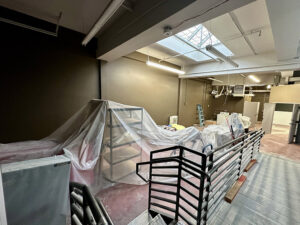
Our team recently had the opportunity to paint the interior of a commercial space in downtown Denver, Colorado. The property owner’s goal is to have a space that clients, competitors, and city residents can view as an example of the new standard for their field. They desire a place where schools and students in their field can visit for a tour to see the latest standards. The business and property owner are also looking to the future for this space and want to have a workspace where employees enjoy spending their time. The employees will spend a reasonable amount of time in this space so it is important to foster an environment that brings out the best in employees. Instead of the usual basic white walls we worked with the client to create a fun but professional environment for all who visit the building.
Challenges Faced in Commercial Interior Painting
One challenge we faced in this commercial interior painting project is common for commercial space. Large and expensive equipment was already in place that couldn’t be moved. As with any painting project, we always take the time to ensure everything is covered properly. This interior painting situation was no different. We took the time needed to ensure all of the equipment and areas that weren’t to be painted were covered properly.
This commercial space didn’t require too much prep work before painting because it wasn’t an operating space yet. New drywall was installed and was ready to be primed and painted. When painting new drywall, you must be sure to primer it before painting. There are specific drywall primers that are the best option for new drywall. The reason primer is so important on new drywall is that if you skip this step, you will end up with a flashing mark. The flashing mark is noticeable to the eye because it is not a consistent color as the rest of the painted areas. If you skip primer on new drywall, the drywall will absorb the paint and not leave a uniform and professional painting finish.
Materials Required for Commercial Painting
This particular commercial space is one the business owner had already invested a significant amount of money into. Due to this, we decided to use a contractor-grade paint from Sherwin Williams, which is a lower-grade paint. Lower-grade paints from Sherwin Williams are still a good option, especially when it comes to budgeting for your interior painting project. The three main differences between using lower-quality and higher-quality paint are the covering capabilities, durability, and finish to the eye. Covering refers to the paint’s ability to cover minor imperfections that a higher-quality paint would cover. Durability refers to the paint’s ability to be wiped with a wet rag and not be damaged. The finish to the eye is how pleasing it is to look at once the paint is applied and cured over the needed time. You most likely can’t tell the difference between these small things unless they are side by side with higher-quality paint.
Cost Factors for Commercial Interior Painting
When calculating interior painting estimates, we base our cost on the total square footage of walls and linear feet of trim and baseboard. You get the total square footage of the walls by measuring each interior wall by its length and height. For a ceiling, you measure the length by the width. This gives us a price, amount of materials, paint, and labor needed in order to prepare and paint an interior area. If you only do the square footage of the space, it will not give you useful measurements because all interior spaces have different sizes of rooms, walls, and designs. There were four doors and door jambs to be painted at this property but no trim or baseboards. The cost of painting the interior of this commercial space was based mostly on square feet of walls and ceilings. Seven different colors were used for this space, which did increase the cost. There was a total of 3,000 square feet of walls, ceilings, and doors throughout this property. Depending on different circumstances, painting a property this size with multiple colors will cost anywhere from $2-$3 per square foot.
Communicate Changes Early
As with many industries, communication is key! When we first met with the property owner, it was expressed that budget was an issue, and they would have us use only two different colors of paint to save time, labor, and materials. However, closer to the start date, the property owner decided they wanted to use a total of seven different colors and add the bathrooms to the project as well. This wasn’t in the original estimate but was something we could make happen for their vision of the space. We understand that your commercial interior painting project is an investment that costs you a good amount of money. We do our best to make your needs a priority on the project.
Through a couple of good conversations, we were able to revise the original estimate and meet the property owner’s request. Once the interior painting was complete and the adjustments had been made, the owner was pleased and is one step closer to opening their business.
